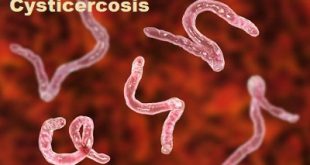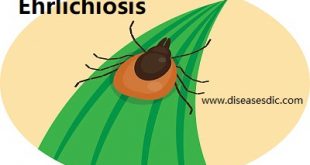Definition
Babesia is a tiny parasite that infects your red blood cells. Infection with Babesia is called babesiosis. The parasitic infection is usually transmitted by a tick bite. Babesiosis often occurs at the same time as Lyme disease. The tick that carries the Lyme bacteria can also be infected with the Babesia parasite.
Image of a blood smear showing Babesia parasites in red blood cells
History
The disease is named for the genus of the causative organism, which was named after the Romanian bacteriologist Victor Babeş. In 1888, Victor Babeş identified the microorganisms in red blood cells as the cause of febrile hemoglobinuria in cattle. In 1893, Theobald Smith and Frederick Kilborne discovered that a tick was the vector for transmission in Texas cattle. The agent was B. bigemina. This was the first demonstration that an arthropod could act as a disease vector to transmit an infectious agent to a vertebrate host.
In 1957, the first human case was documented in a splenectomized Croatian herdsman. The agent was B. divergens. In 1969, the first case was reported in an immunocompetent individual on Nantucket Island. The agent was B. microti, and the vector was the tick I. scapularis.[citation needed]Equine babesiosis is also known as piroplasmosis (from the Latin piro, meaning pear + Greek plasma, a thing formed).
Epidemiology
Babesiosis occurs in areas of Europe and Asia, where the tick vector and vertebrate host reside, and it occurs in healthy as well as asplenic persons. On the whole, however, it is rare in Europe. Since 1957, when the first case of human babesiosis was reported in an asplenic farmer from the former Yugoslavia, approximately 40 cases have been reported, mostly in Ireland, the United Kingdom, and France. All of the cases involved bovine Babesia and occurred in individuals who were splenectomized.
Sporadic case reports of babesiosis in Japan, Korea, China, Mexico, South Africa, and Egypt have also been documented. One report describes human Babesia infection in Columbia.
The connection between babesiosis and Lyme disease
- The same tick that carries the Babesia parasite can also carry the corkscrew-shaped bacteria responsible for Lyme disease.
- Studies carried out in areas of southern New England, where Lyme disease is prevalent, found that 11 percent of people diagnosed with Lyme were also infected with Babesia. Researchers also found that the babesiosis often went undiagnosed.
- According to the CDC, most cases of babesiosis occur in New England, New York, New Jersey, Wisconsin, and Minnesota. These are states where Lyme disease is also prevalent, though Lyme is also prevalent elsewhere.
- The symptoms of babesiosis are similar to those of Lyme disease. Coinfection with Lyme and Babesia can cause the symptoms of both to be more severe.
Risk factors
Common risk factors
- Being bitten by an infected tick
- Residing in an endemic area, primarily the Northeastern, United States coast
- Repeated exposure to common I. scapularis and Ixodes hosts; white-footed deer mice, rats, voles, chipmunks, and field mice
- Outdoor recreational activity during seasons of high tick activity
Less common risk factors
- Patients with a medical history including a splenectomy or any immunocompromising diseases
- Receiving a blood transfusion from a donor residing in an endemic area
- Elderly individuals are more susceptible to infection (Most cases occur within patients of 50 to 60 years)
Causes of Babesiosis
- People get babesiosis when an infected tick bites them. The Babesia parasite is usually spread when the tick is in its nymph stage. At that stage, the tick is the size of a poppy seed. It can be hard to detect a tick this small.
- Ticks live in areas with a lot of plant life, such as wooded areas or fields. They sit near the top of grassy plants and low bushes. They wait there for people or animals to brush up against them. Ticks can crawl on your clothes or body for several hours before attaching to the skin.
- Ticks can attach to any part of your body. They are usually found in hard-to-see areas, including the armpits, groin, or scalp. An infected tick needs to be attached to your skin for 36 to 48 hours before it passes the parasite on to you.
- People who spend time in outdoor areas where ticks are common are at higher risk of getting tick-borne diseases.
- Though rare, it is possible to get babesiosis through a blood transfusion. It is also possible for an infected mother to pass the parasite to her baby. This can happen during pregnancy or delivery. This is also rare.
Image of Babesiosis
Symptoms of Babesiosis
Symptoms of babesiosis usually start 1 to 8 weeks after you are bitten by a tick. Some people may not have any symptoms. When symptoms do occur, they are often similar to symptoms of the flu:
- Fever (as high as 104°F)
- Chills
- Sweating
- Weakness
- Fatigue
- Joint and muscle aches
- Loss of appetite
- Headache
In young, healthy adults, the infection usually isn’t severe. But the illness can quickly become serious, and can even cause death. Babesiosis could be life-threatening in people who:
- Are elderly.
- Have had their spleen removed.
- Have liver or kidney disease.
- Have weak immune systems (due to conditions such as HIV/AIDS or cancer).
Diagnosis and test
- Sometimes, babesia can be detected in blood examined under a microscope. However, this method is reliable only in the first two weeks of the infection.
- Commercial tests currently detect only two strains of Babesia and there are likely many strains yet to be discovered.
- The PCR (polymerase chain reaction) test can detect babesia DNA in the blood.
- The FISH (Fluorescent In-Situ Hybridization) assay can detect the ribosomal RNA of Babesia in thin blood smears.
- The lab can also test the patient’s blood for antibodies to Babesia. It may be necessary to run several different tests, and negative results should not be used to rule out treatment.
Treatment and medications
Combination therapy with atovaquone (Mepron) and azithromycin is most commonly recommended for treatment of mild to moderate babesiosis. Treatment is usually continued for 7-10 days. A combination regimen of oral clindamycin and quinine has also been proven effective, but the rate of adverse reactions is significantly higher with this combination, so it is not recommended for treatment of uncomplicated disease.
For patients with severe babesiosis, however, intravenous clindamycin and (oral) quinine is considered the preferred treatment, again for 7-10 days. In patients with underlying immunosuppression and persistent signs and symptoms, studies have shown an association between longer treatment duration and a positive outcome; therefore, treatment of these individuals should be continued for weeks or months until blood smears are negative for at least two weeks. Extended treatment is not considered necessary for immunocompromised patients who respond clinically to the 7-10 day treatment course.
Prevention and control of Babesiosis
Steps can be taken to reduce the risk for babesiosis and other tickborne infections. The use of prevention measures is especially important for people at increased risk for severe babesiosis (for example, people who do not have a spleen). Avoiding exposure to tick habitats is the best defense.
Babesia microti is spread by Ixodes scapularis ticks, which are mostly found in wooded, brushy, or grassy areas, in certain regions and seasons. No vaccine is available to protect people against babesiosis. However, people who live, work, or travel in tick-infested areas can take simple steps to help protect themselves against tick bites and tickborne infections.
During outdoor activities in tick habitats, take precautions to keep ticks off the skin.
- Walk on cleared trails and stay in the center of the trail, to minimize contact with leaf litter, brush, and overgrown grasses, where ticks are most likely to be found.
- Minimize the amount of exposed skin, by wearing socks, long pants, and a long-sleeved shirt. Tuck the pant legs into the socks, so ticks cannot crawl up the inside of the pants. Wear light-colored clothing, to make it easier to see and remove ticks before they attach to skin.
Apply repellents to skin and clothing. Follow the instructions on the product label.
- Products that contain DEET (N,N-diethylmetatoluamide) can be directly applied to exposed skin and to clothing, to help keep ticks away (by repelling them). The product label includes details about how and where to apply the repellent, how often to reapply it, and how to use it safely on children.
- Permethrin products can be applied to clothing/boots (not to skin), actually kill ticks that come in contact with the treated clothing, and usually stay effective through several washings.
Repellents applied to exposed skin
After outdoor activities, conduct daily tick checks and promptly remove any ticks that are found. Thorough, daily tick checks are very important. The I. scapularis nymphs that typically spread B. microti are so small (about the size of a poppy seed) that they are easily overlooked. But they usually must stay attached to a person for more than 36-48 hours to be able to transmit the parasite.
- Remove ticks from clothing and pets before going indoors.
- Conduct a full-body exam for ticks. Use a hand-held or full-length mirror to view all parts of the body. Be sure to check behind the knees, between the legs (groin/thighs), between the toes, under the arms (armpits), around the waist, inside the belly button, the back of the neck, behind and in the ears, as well as in and around the scalp, hairline, and hair. Remember to check children and pets, too.
Remove ticks that are attached to the skin as soon as possible, preferably by using pointed (fine-tipped) tweezers. Grab the tick’s mouth parts close to the skin, and slowly pull the tick straight out (with steady outward pressure), until the tick lets go.
 Diseases Treatments Dictionary This is complete solution to read all diseases treatments Which covers Prevention, Causes, Symptoms, Medical Terms, Drugs, Prescription, Natural Remedies with cures and Treatments. Most of the common diseases were listed in names, split with categories.
Diseases Treatments Dictionary This is complete solution to read all diseases treatments Which covers Prevention, Causes, Symptoms, Medical Terms, Drugs, Prescription, Natural Remedies with cures and Treatments. Most of the common diseases were listed in names, split with categories.







They need to be destroyed
is clindamycin be used in children?
Clindamycin is used in children. but the dosage will vary based on children weight. The pediatric clindamycin dosage is 25 mg per kg per day